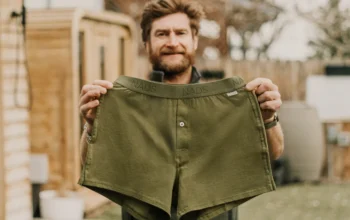Walk into any clothing store and you’ll see polyester everywhere shirts, leggings, dresses, suits, and even sports jerseys. It’s one of the most widely used fabrics in the world. But when shopping, a common question arises: is polyester stretchy?
At first glance, the answer seems simple: polyester isn’t naturally very stretchy. But the truth is more nuanced. Depending on how it’s made, blended, or woven, polyester can behave very differently. Some polyester garments feel stiff and structured, while others stretch easily for movement and comfort.
This guide explores everything you need to know about polyester and stretch: from how the fabric is made, to why it stretches in certain conditions, to comparisons with other popular materials. By the end, you’ll know exactly what to look for when choosing polyester clothing.
What Exactly Is Polyester Fabric?
Polyester is a synthetic fabric made from materials derived from petroleum.More specifically, it’s made from a type of plastic called polyethylene terephthalate (PET). Manufacturers produce it through a chemical process that turns petroleum into long polymer chains. These chains are then spun into fibers and woven or knitted into fabric.
Why Polyester Became Popular
- Durability: Strong and resistant to tearing.
- Wrinkle resistance: Maintains shape without ironing.
- Affordability: Cheaper than many natural fibers.
- Moisture resistance: Doesn’t absorb water like cotton.
- Colorfastness: Holds dyes well, making bright colors last.
Polyester was first introduced in the 1940s and surged in popularity during the 1970s. Today, it’s found in everything from high-end fashion to everyday basics and industrial textiles.
Yet for all its strengths, polyester’s chemical structure makes it less elastic than natural stretch fibers like wool or synthetic stretch champions like spandex.
Does 100% Polyester Stretch?
In short: no, not much. If you buy a garment labeled 100% polyester, don’t expect significant give.
The polymer chains in polyester are tightly bound, which makes the fabric strong but not naturally stretchy. You can pull on a polyester shirt, and it will resist stretching, bouncing back to its original shape rather than expanding to fit your body.
Example Scenarios
- Polyester dress shirt: Holds its crisp shape throughout the day but feels stiff.
- Polyester trousers: Keep structure well but don’t allow much flexibility for movement.
- Polyester jacket: Resists wrinkles but offers little comfort stretch.
This rigidity is useful in some contexts like formal clothing where structure is key. But for sportswear or casual comfort, pure polyester may not cut it.
What Makes Polyester Stretchy?
Here’s where things get interesting: polyester can become stretchy, but it usually requires help.
1. Blends with Other Fibers
The most common way to make polyester flexible is by blending it with other fibers:
- Polyester + Spandex (Lycra/Elastane): Even a 5–10% spandex blend makes polyester incredibly stretchy. This is why leggings, yoga pants, and compression wear feel so flexible.
- Polyester + Cotton: Adds softness and comfort. Cotton brings breathability, while polyester keeps durability. Stretch is modest but noticeable.
- Polyester + Rayon or Nylon: Can improve drape and slight flexibility.
Case in point: A pair of leggings labeled 90% polyester, 10% spandex will feel entirely different from pants made of 100% polyester.
2. Knit vs. Woven Construction
The way fabric is made dramatically affects stretch:
- Knitted polyester fabrics: Loops of fiber interlock, allowing more flexibility. Sports jerseys and T-shirts often use this method.
- Woven polyester fabrics: Fibers are interlaced tightly, creating less give. Suits, trousers, and jackets often use woven polyester.
Example comparison:
- A polyester jersey stretches as you move on the soccer field.
- A polyester blazer doesn’t budge, holding its form no matter what.
3. Fabric Treatments and Innovations
Textile technology has advanced so much that polyester can be engineered for stretch without adding spandex. Manufacturers use mechanical stretch treatments or heat processes to alter polyester’s structure slightly, making it more flexible while still retaining durability.
Pros and Cons
Like any fabric, polyester’s stretch has both strengths and weaknesses.
Advantages
- Shape retention: Polyester doesn’t sag or lose form, even after repeated wears.
- Wrinkle resistance: Perfect for travel or work clothes.
- Durability: Handles wear and tear better than cotton.
- Great for activewear: Blended polyester stretches enough for yoga, running, or swimming.
Disadvantages
- Limited breathability: Can trap heat and moisture.
- Comfort concerns: Pure polyester feels stiff against skin.
- Environmental footprint: Made from petroleum, not sustainable.
- Not naturally elastic: Needs blends or knits to achieve real stretch.
When Wet or After Washing?
Some fabrics, like cotton, absorb water and stretch when wet. Polyester behaves differently.
- Hydrophobic: Polyester repels water, meaning it doesn’t swell when wet.
- Minimal wet stretch: Polyester maintains its size and shape in water.
- After washing: Polyester resists shrinking or stretching better than natural fabrics.
This is why polyester is popular in swimwear, sportswear, and outdoor gear. It doesn’t sag when soaked and dries quickly.
Polyester vs. Other Fabrics
How does polyester stack up against other common fabrics when it comes to stretch?
| Fabric | Natural Stretch | Comfort | Durability | Breathability | Common Uses |
| Polyester | Low (unless blended) | Medium | High | Low-Medium | Sportswear, upholstery, shirts |
| Cotton | Medium (depends on knit) | High | Medium | High | Everyday clothing, bedding |
| Nylon | Medium-High | High | High | Medium | Activewear, outerwear |
| Spandex | Very High | High | Medium | Low | Leggings, swimwear, performance wear |
Key Takeaway
- Polyester is less stretchy than nylon and spandex.
- Polyester blends can compete in comfort and flexibility.
- Polyester outperforms cotton in durability but not in breathability.
How to Make More Comfortable and Flexible
If you want polyester clothes that stretch and feel good, here’s what to look for:
- Pick blends wisely Spandex blends are best for movement, cotton blends for softness.
- Choose knits over wovens Knit polyester fabrics stretch more.
- Check fabric labels Look for at least 5 10% spandex in activewear.
- Avoid high heat Polyester can warp or melt under extreme temperatures, reducing comfort.
- Buy performance polyester Brands now create engineered fabrics with built-in stretch.
Tip: If comfort is your priority, never settle for 100% polyester in activewear. Always go for blends.
FAQs
Does polyester stretch over time?
Not really. Polyester is designed to resist stretching and sagging. Unlike cotton, which loosens with repeated wear, polyester stays firm.
Is polyester good for leggings and yoga pants?
Yes but only when blended with spandex or elastane. Pure polyester leggings would feel stiff and restrictive.
Can polyester shrink instead of stretch?
Polyester rarely shrinks. Under very high heat, though, it can warp, melt, or slightly tighten.
Is polyester stretchy enough for bedding?
Pure polyester sheets aren’t stretchy. Blends with microfiber or elastane may feel softer and slightly more flexible.
Case Study: Sportswear
A professional soccer team switched from cotton-based jerseys to polyester-spandex blends. Players reported:
- Greater freedom of movement.
- Faster drying times during games.
- Less sagging when drenched in sweat or rain.
This demonstrates how blended polyester fabrics outperform pure polyester or cotton in athletic settings.
Conclusion
So, is polyester stretchy?
- On its own, 100% polyester isn’t naturally stretchy.
- However, polyester becomes flexible when blended with spandex, cotton, or elastane, or when knitted instead of woven.
- Polyester stretchiness depends on fabric construction, blends, and treatments.
If you want structure and wrinkle resistance, choose pure polyester. If you want flexibility and comfort, look for blends with spandex or cotton.
Final word of advice: Always check the clothing label. Even a small amount of spandex (5–10%) can transform stiff polyester into a comfortable, stretchy fabric perfect for active or casual wear.



